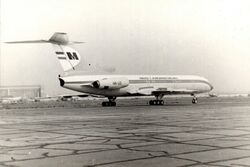Unsolved:Malév Flight 240
 HA-LCI, the aircraft involved in the accident, seen earlier in 1975 | |
| Occurrence | |
|---|---|
| Date | 30 September 1975 |
| Summary | Crashed into sea; cause undetermined |
| Site | Mediterranean Sea near Beirut International Airport, Beirut, Lebanon |
| Aircraft | |
| Aircraft type | Tupolev Tu-154B-2 |
| Operator | Malév Hungarian Airlines |
| Registration | HA-LCI |
| Flight origin | Budapest Ferihegy International Airport, Budapest, Hungary |
| Destination | Beirut International Airport, Beirut, Lebanon |
| Passengers | 50 |
| Crew | 10 |
| Fatalities | 60 |
| Survivors | 0 |
Malév Flight 240 was a regular service from Budapest Ferihegy International Airport, Hungary, to Beirut International Airport, Lebanon. On 30 September 1975, the aircraft operating the route, a Tupolev Tu-154 of Malév Hungarian Airlines, on its final approach for landing, crashed into the Mediterranean Sea just off the coast of Lebanon. All fifty passengers and ten crew on board are thought to have been killed.[1][2] No official statement was ever made on the crash and its cause has never been publicly disclosed.
On 27 September 2007, Hungarian politician György Szilvásy, then Minister of Civil Intelligence Services, wrote a letter[3] to Róbert Répássy, Fidesz party member of the Hungarian Parliament, stating that Hungarian civilian national security services (Információs Hivatal and Nemzetbiztonsági Hivatal) had produced a report on the crash in 2003, and that the report stated that there were no available original (secret service) documents concerning the case. Szilvásy's letter affirmed that the report remains top secret, for reasons not connected to the crash.[3]
Hungarian television station Hír TV has carried a documentary film covering the incident.[4][better source needed] In December 2008, Dutch broadcaster NTR aired a piece on Malév Flight 240 alleging that there is existing photographic documentation of the search and rescue or recovery operation, and that fifteen unidentified bodies were recovered.[5]
According to unidentified witnesses, the plane was shot down, seen by a British military pilot and radar operators on a British radar station in Cyprus.[6][7]
References
- ↑ "Malév Flight 240 Accident description". Aviation Safety Network. https://aviation-safety.net/database/record.php?id=19750930-1.
- ↑ "Accident Synopsis 09301975". http://www.airdisaster.com/cgi-bin/view_details.cgi?date=09301975®=HA-LCI&airline=Malev.
- ↑ 3.0 3.1 "Letter from György Szilvásy to Róbert Répássy". 27 September 2007. http://www.mkogy.hu/irom38/03713/03713-0001.pdf.
- ↑ CINEMART Productions of Hungary; Producer: Ferenc Szohár
- ↑ "Den Haag Vandaag (The Hague Today)". NTR. 20 December 2008. https://www.ntr.nl/player?id=NPS_1099780&ssid=203.
- ↑ Budai, Miklós (8 October 2018). "Still no hope in the most mysterious crash – Aeronautics" (in en-US). https://aeronauticsonline.com/still-no-hope-in-the-most-mysterious-crash/.
- ↑ "Crash of Malév Flight 240" (in en). https://worldhistoryproject.org/1975/9/30/crash-of-malev-flight-240.
External links
- Magazine article in Hetek news magazine (in Hungarian), 12 December 2003
- News article in Nethírlap online newspaper (in Hungarian), 30 September 2005
- The Lost Malev – website dedicated to Malév Flight 240
Video recordings
 Titkok légijárata (Flight of Secrets) – Youtube.com, documentary in Hungarian
Titkok légijárata (Flight of Secrets) – Youtube.com, documentary in Hungarian Az elveszett járat - MA 240 (The lost flight - MA 240) – Youtube.com, documentary in Hungarian
Az elveszett járat - MA 240 (The lost flight - MA 240) – Youtube.com, documentary in Hungarian
 |

